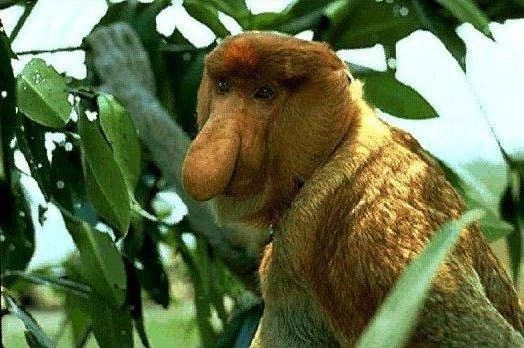|
| Query: Long-nosed monkey | Result: 6th of 33 | |
Proboscis Monkey (Nasalis larvatus) - Wiki
| Subject: | Proboscis Monkey (Nasalis larvatus) - Wiki
| |

| Resolution: 524x348
File Size: 53190 Bytes
Upload Date: 2007:10:08 14:37:08
|
Proboscis Monkey
From Wikipedia, the free encyclopedia
[Photo] Proboscis Monkey (Nasalis larvatus). Photo by Nemesea | Permission is granted to copy, distribute and/or modify this document under the terms of the GNU Free Documentation License, Version 1.2 or any later version published by the Free Software Foundation; with no Invariant Sections, no Front-Cover Texts, and no Back-Cover Texts. A copy of the license is included in the section entitled "GNU Free Documentation License". |
The Proboscis Monkey (Nasalis larvatus), also known as the Long-nosed Monkey, is a reddish-brown arboreal Old World monkey. It is the only species in monotypic genus Nasalis.
Appearance
The most distinctive trait of this monkey is the male's large protruding nose. The purpose of the large nose is unclear, but it has been suggested that it is a result of sexual selection. The female Proboscis Monkey prefers big-nosed male, thus propagating the trait.
Males are much larger than females, reaching 72 cm (28 inches) in length, with an up to 75 cm tail, and weighing up to 24 kg (53 pounds). Females are up to 60 cm long, weighing up to 12 kg (26 lb).
The Proboscis Monkey also has a large belly, as a result of its diet. Its digestive system is divided into several parts, with distinctive gut flora, which help in digesting leaves. This digestive process releases a lot of gas, resulting in the monkey's "bloated" bellies. A side-effect of this unique digestive system is that it is unable to digest ripe fruit, unlike most other simians. The diet consists mainly of fruits, seeds and leaves.
Ecology
The Proboscis Monkey is distributed and endemic to the coastal mangrove, swamps and riverine forests of Borneo. It lives in small groups of 10 to 32 animals. Group membership is very flexible, and animals are known to move from group to group quite often.
The Proboscis Monkey lifestyle is both arboreal and amphibious, with its mangrove swamp and riverine environment containing forest, dry land, shallow water allowing wading, and deep water requiring swimming. Like other similar monkeys, the Proboscis Monkey climbs well. It is also a proficient swimmer, often swimming from island to island, and has been picked up by fishing boats in open ocean a mile from shore. While wading, the monkey uses an upright posture, with the females carrying infants on their hip. Troops have been filmed continuing to walk upright, in single file, along forest trails when they emerge on land, the only non-human mammal, with the exception of gibbons and giant pangolins, known to use this form of locomotion for any length of time.
Status
Due to ongoing habitat loss and hunted in some areas, only about 7000 are known to still exist in the wild. In Sarawak, the population of this species has declined from 6500 in 1977 to only 1000 in 2006. The Proboscis Monkey is evaluated as Endangered on the IUCN Red List of Threatened Species. It is listed on Appendix I of CITES.
Other names
While the official Indonesian name for this monkey is Bekantan, an Indonesian nickname is 'monyet belanda', meaning 'Dutch monkey' or 'Orang Belanda', the Indonesian word for 'Dutchman', as Indonesians noticed the Dutch colonisers often also had a large belly and nose.
http://en.wikipedia.org/wiki/Proboscis_Monkey
| The text in this page is based on the copyrighted Wikipedia article shown in above URL. It is used under the GNU Free Documentation License. You may redistribute it, verbatim or modified, providing that you comply with the terms of the GFDL. |
|
Comments |
|---|
| | Guest |
|
Scientific Name: Nasalis larvatus (Wurmb, 1787)
Common Names: Proboscis Monkey, Long-nosed Monkey, [French] Nasique, [Spanish] Mono Narigudo
Synonyms:
Nasalis capistratus (Kerr, 1792)
Nasalis nasica (Lacépède, 1799)
Nasalis recurvus Vigors & Horsfield, 1828
Simia capistratus Kerr, 1792
Cercopithecus nasica Lacépède, 1799 |
^o^
Animal Pictures Archive for smart phones
^o^
|
|
|